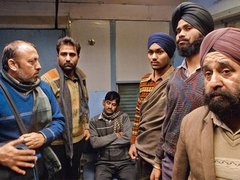Chauthi Koot
wogma rating: Add to 'must watch' list (?)
If tense, minimal, gloomy movies about human condition interest you, do add it to your must-watch list.
Read more- 5854 views
- 0 comments
- Add comment
Chauthi Koot or the Fourth Direction provides a close glimpse of the directionlessness and dilemmas faced by ordinary citizens caught between the militants and the military in the state of Punjab (India) in 1984.
It also uses a technique, which I would like to call pseudo-climax, in which you are given the illusion that the story has reached its natural peak but the filmmaker is just playing with your sentiments
It builds a tense atmosphere right from the beginning when two men get down from a rickety bus and begin to walk fast in desperation. The camera tracks them and follows them from the outskirts, where they alight, to throughout the city. Who are they? What colid have happened? What are they up to? A lot of questions come to the mind. The net reslit is that you find yourself captivated.
However, the director doesn't make any effort to introduce them any further. So, an uncertainty over what to exactly make of them prevails. They remain strangers, to the city and to us. But this is not the main story. This is just the framing story through which the director prepares us to suspect the film's characters and thus succeeds in putting us in a paranoid state of mind, the sort that may be rampant during the times of communal tension, when trusting anybody is not easy.
Slowly, the framing narrative dissolves into the main story. For me, this was the finest part of the film--how the framing narrative leads you on. Without really ever letting you know that you are being brought into a particliar village household, where you are going to stay for a large part of the film. Here, amidst a palpably eerie and fearful atmosphere, an Amorres-Perros-like tale unfolds, underlining the irony of human existence.
Cauthi Koot is a fine example of minimal filmmaking, where the idea is to achieve more through less. The cinematic elements are reduced to a bare minimum, for example:
- the background score is entirely absent (for enhanced eeriness) or is replaced with selected ambient diegetic sounds (for intensified mood),
- the editing is straightforward because most shots use long takes,
- the shots combine camera tracking with still frames, so a moment is exposed almost in real time to the film's characters as well as the audience, thus enhancing the immersiveness,
- the camera angles are clean, and the framing and composition is almost by the book (a couple of frames in the film are so beautiful, they remind you of picnic scenes painted by Monet and Renoir),
- the dialogues are optimized and the emphasis is on expression and body language, and
- the sets are replaced with real locations, and local character actors replace commercial names, so the establishment of milieu is easy and pretense-less.
Chauthi Koot employs all of these to further achieve and convey the paranoia and distrust that prevailed during the times of Punjab militancy. It also uses a technique, which I would like to call pseudo-climax, in which you are given the illusion that the story has reached its natural peak but the filmmaker is just playing with your sentiments - the real peak and resolve are still far and one has to continue to roll towards them. And when they actually arrive, the suddenness and abruptness shock you - things happen sans the cinematic build-up, just like they wolid in real life. The reality is harsher and more ironic than how a filmmaker would prepare you to face it. You could even say that the filmmaker himself leaves the pretense of filmmaking midway, after the pseudo-climax, and adopts a more maverick route to bring you to a realistic destination.
This latter maverick part may seem scattered, the events don't look well-connected, but that's because the filmmaker has literally loosened his grip over the characters. An Iranian filmmaker, Jafar Panahi, had played with this technique in his 1997 film Ayneh (The Mirror), wherein the storytelling suddenly changes tracks at its peak - the pseudo-climax, to leave its scripted and dramatized outlook to acquire an unscripted and candid documentary-like form. Chauthi Koot doesn't go that far but, yes, you would be a little perplexed after its pseudo-climax.
his was the finest part of the film--how the framing narrative leads you on.
However, structured or semi-structured, the journey is worth taking. The movie is worth watching. The paranoia is worth experiencing. If tense, minimal, gloomy movies about human condition interest you, do add it to your must-watch list.
This review is by guest reviewer Jeet. Jeet is a workaholic turned film addict, and vice-versa. Basically, when he is not working, he is watching films. And when he isn't watching films, he is working. The funny thing is films are also a part of his work. Go figure!
External reviews for this movie are not available
Twitter reviews for this movie are not available.
No readers have rated this movie yet.
This page has additional observations, other than the ones noted in the main review.
Parental Guidance:
- Violence: Sounds of gunfire; a man hit by a cop
- Language: Clean
- Nudity & Sexual content: None
- Concept: The aftermath of militancy
- General Look and Feel: Well composed and framed, dramatically lit







Comments (0)
There are no comments on this entry yet.Leave a Comment